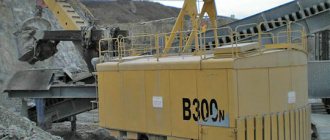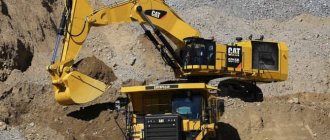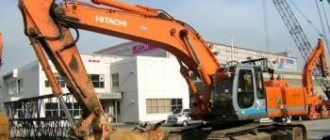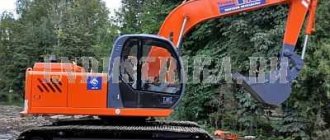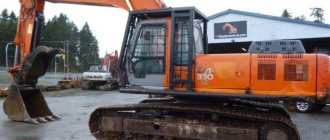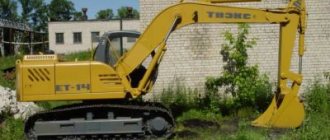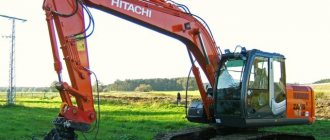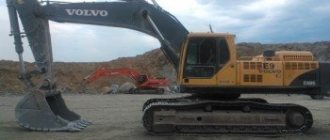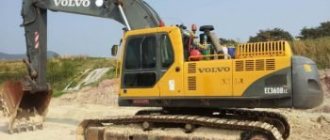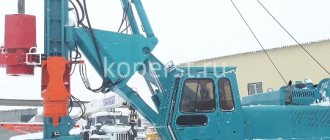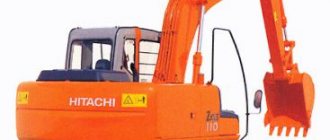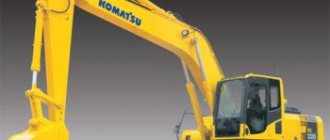A quarry excavator belongs to the category of large special equipment designed to work with large volumes of materials (soil, crushed stone, etc.). In the form in which this technology is known today, it appeared in 1936, when the American mining industry was actively developing and needed large, high-performance machines that could move around the quarry. Many types of minerals are currently mined by open-pit mining. This determines the demand and active use of mining excavators.
Areas of application
Such machines are used in the following types of open areas:
- mining and quarrying - in coal mining, development of ore and non-metallic deposits, in non-ferrous and ferrous metallurgy;
- construction and road construction - when preparing a site for the construction of large buildings, laying highways and highways.
The main types of work performed using a mining excavator:
- digging and extraction of materials (coal, ore, soil, etc.);
- site clearing;
- moving materials along a horizontal plane;
- loading materials onto transport for subsequent transportation.
The use of quarry excavators is appropriate wherever large amounts of work need to be performed. Otherwise, machines from the categories of medium or small-sized equipment are used.
Principle of operation
Quarry excavators are tracked, which ensures their ability to move freely over terrain with different terrain, including hilly and rough areas, ledges of quarries, etc. The main working element of such equipment is the bucket. Its design may vary depending on the type of task being performed. The machine's operating cycle consists of two basic stages:
- direct digging;
- moving material to the dump site or to the loading point.
Depending on the type of work performed, a crawler mining excavator can be equipped with a variety of attachments.
Design Features
The design of a mining excavator includes the following basic elements:
- body,
- arrow,
- turntable,
- bottom frame,
- two-legged stand,
- ladle,
- track frames,
- handle.
High-strength steel is used for the manufacture of structural elements, which makes them resistant to loads. This technique is capable of performing large-scale work at a wide range of external temperatures.
The reliability and endurance of mining excavators are also determined by design solutions, including:
- specialized mechanisms for braking the bottom of the bucket, which reduce vibrations of the bottom and prevent it from hitting the handle or body;
- the use of a leveling block in the bucket suspension, which reduces the load on the boom during work;
- half-blocks mounted on the handle beam, which increases the latter’s endurance and resistance to loads.
The principle of the walker device
The main purposes of this structural element are to provide movement and redirect the load to the supporting surface from the control units and the bucket. Modern excavators are available in 2 versions:
- wheeled;
- tracked
In the first case, the unit includes 2 axles with a drive. The front axle has movable knuckles, which are responsible for the ability to turn while driving. There are also stabilizers on the steering axle, whose task is to ensure lateral stability of the vehicle. The advantage of special vehicles on wheels is the speed of movement. Excavators on pneumatic tires are able to move faster between different work sites without involving additional modes of transport. The wheels are supplemented with a drive with individual hydraulic motors or operate from a single internal combustion engine; there is no suspension. To increase torque, the hubs are equipped with planetary gearboxes.
Important: wheeled models have pneumatic brakes. Compressed air is supplied through a compressor that is installed in the engine. Pneumatics also ensure the operation of the differential locking mechanism and connect the front axle (when towing, to the brake system of the tractor).
Crawler excavators are equipped with special mechanisms that are responsible for varying the track and improving the stability of the equipment. Such models are characterized by low movement speed. When moving over long distances, trailers are used to transport them. When excavating in swamps, extended tracks are used. They are installed on drive wheels and rollers.
Tools
To expand functionality, tracked mining excavators are equipped with attachments. Its most popular varieties include:
- grab. It is a type of bucket, which consists of two jaw-shaped elements. Thanks to this design, the grab can create narrow holes in the ground and remove soil from them without expanding the walls. Such buckets are also suitable for loading and unloading operations;
- tap. With its help, cargo is moved, which eliminates the need to equip the site with additional lifting equipment;
- dragline. This element provides for the connection of a rope and a boom with a flexible coupling and is used when performing quarry work, less often - when cleaning reservoirs, in construction;
- straight shovel. It is a type of bucket that has a hinged bottom. A deadbolt and replaceable teeth are also provided. According to the type of handle, straight shovels are single- and double-beam;
- backhoe. Such equipment consists of a boom, a bucket, a stand and a handle. The bucket is attached to a handle, which is fixed to the stand. When the rope is pulled, the handle moves counterclockwise, causing the bucket to sink into the ground.
Types of replaceable working bodies for hydraulic excavators
- Backhoes of various capacities for digging holes below the parking level of the machine, unloading soil, and cleaning the base of the face. Rotation of the bucket relative to the handle allows you to work in cramped conditions, in close proximity to utility lines.
- Straight shovels with a rotating bucket for developing soils both above and below the parking level, for loading activities. The equipment allows you to plan and clear the base in the face.
- Special buckets for digging narrow trenches and drainage work.
- Double-jaw grabs for digging pits, wells and trenches, for loading stones and large pieces of materials, digging deep holes, including in cramped conditions. The equipment is attached instead of a bucket to the handle of a backhoe. Longitudinal and transverse rocking of the grab is possible. To dig wells up to 30 m deep, the equipment uses intermediate extension inserts.
- Buckets with continuous cutting edge and teeth. Used for cleaning and leveling work.
- Loading buckets of increased capacity for delivering small-sized and bulk materials to a level located above the machine parking lot, for developing and loading soil into vehicles or dumping it into a dump.
- Bulldozer blades. Used for filling trenches, holes, small pits.
- Special grips for logs and pipes.
- Crane suspension for installation and lifting work.
- Single-shank and multi-shank rippers for working with dense, frozen soils, for breaking up asphalt pavements.
- Hydraulic, pneumatic, hydropneumatic hammers with replaceable working bodies for the destruction of rocky soils, brickwork, reinforced concrete, road surfaces, foundations, soil compaction, crushing oversized pieces of rock, driving sheet piles and piles.
Specifications
The main characteristic of a mining excavator is the capacity of its bucket. Depending on the model, it can reach 50 m3. The greater the capacity, the higher the productivity of the excavator, since the volume of cargo that it can move at one time increases. In addition, the following characteristics of this technology are important:
- boom length – up to 55 m;
- excavator movement speed – up to 2.5 km/h;
- working cycle – about 50 s;
- caterpillar width – up to 24 m;
- radius of scooping and unloading – up to 24 m;
- digging and clearing radius – up to 30 and 20.4 m, respectively;
- unloading and digging heights – up to 24 and 21 m, respectively;
- ground pressure – up to 0.42 MPa.
The largest
One of the largest and most popular on the Russian construction market is the model of the EKG-15 quarry crawler excavator.
This model is suitable for the following range of work:
- Development and opening of rocks.
- Opening up rocks that cover minerals.
- Removal of dumps, chalk and quartz deposits.
- Passing wide, so-called cut trenches.
- Unloading rocks into trailers and cars.
The largest EKG-15 unit weighs about 672 tons, has a bucket capacity of up to 15 m³, a boom length of 18 m, a digging height of 16.4 m, and a digging radius of 22.6 m.
Before choosing the best and most reliable mechanism of this type, you should carefully study its technical characteristics and pay attention to the following nuances:
- Conditions under which the technique can be used.
- Productive power.
- Number of buckets.
- Chassis.
- Control features.
Most often, tracked quarry machines are purchased because they have high productivity, are able to stand on moving soil, and have optimal weight that is correctly distributed over the surface of the earth. When choosing a car, attention should be paid to the products of the companies MAZ, BelAZ, Hyundai, OMZ, Uralmash, Karstyazhmash, Caterpillar, Komatsu.
Tractor Rusich
Tractor centaur
Dt 75 Kazakhstan
Mini-excavator with your own hands: from searching for drawings to the assembly process
Review of the model range of YuMZ excavators: technical characteristics of YuMZ-6, EO-2621, how much the Petushok tractor weighs
Technical characteristics and modifications of the EO-4225 excavator
Classification (types)
According to the regulatory documents of the Russian Federation, the following types of quarry excavators are distinguished.
- ECG. This is a tracked vehicle, the bucket of which is lifted using ropes. The machine is widely used for construction and quarry work.
- EG. The lifting of the bucket in such crawler excavators is carried out using a hydraulic mechanism.
- EGO. This abbreviation refers to backhoe excavators.
- EDH. Such excavators are equipped with a dragline.
- ECR. This is a rail-walking or crawler-type rotary excavator equipped with several buckets.
- ECG. It is a universal hydraulic excavator with one bucket driven by a hydraulic system.
There are also other options for classifying mining excavators:
- by the number of caterpillars - 2, 4 or 8;
- drive type – hydraulic, mechanical, electric, hydromechanical;
- type of working cycle - cyclic and continuous;
- angle of rotation - full and partial rotation.
The foreign classification of such special equipment differs from the Russian one.
Classification of excavators by engine type
Diesel
Excavators of this type are mobile in operation, but their use requires fuel costs. The lack of economy is compensated by the ability to quickly move equipment from one site to another.
Electrical
This class of excavators is less expensive in terms of power resources, but is not characterized by mobility. If it is possible to attach equipment to one construction site for a long time, then electrical type equipment is used.
← How to choose the right bulldozer
Backhoe loaders: characteristics →
Backhoe loaders
JCB 3CX
| Digging depth | 5.46 m. |
| Bucket volume | 1.0 m 3 |
| rent price | 11000 rub. |
Caterpillar 432F
| Digging depth | 4.87 m. |
| Bucket volume | 1.03 m 3 |
| rental price (7+1) | 11000 rub. |
Volvo BL71B
| Digging depth | 5.35 m. |
| Bucket volume | 1.0 m 3 |
| rental price (7+1) | 11000 rub. |
Wheeled excavators
JCB JS175W
| Digging depth | 6.23 m. |
| Bucket volume | 0.9 m 3 |
| rent price | 9600 rub. |
Doosan S180W-V
| Digging depth | 6.0 m. |
| Bucket volume | 0.93 m 3 |
| rental price (7+1) | 9600 rub. |
Hyundai R200W-7
| Digging depth | 6.38 m. |
| Bucket volume | 0.8 m 3 |
| rental price (7+1) | 9600 rub. |
Crawler excavators
Hitachi ZX 180 LCN-5G
| Digging depth | 6.2 m. |
| Bucket volume | 0.7 m 3 |
| rental price (7+1) | 10,000 rub. |
JCB JC220LC
| Digging depth | 6.6 m. |
| Bucket volume | 1.2 m 3 |
| rent price | 10800 rub. |
JCB JS330
| Digging depth | 8.2 m. |
| Bucket volume | 1.85 m 3 |
| rent price | 13000 rub. |
Selection rules
When choosing crawler mining excavators, we start from the following basic factors:
- equipment power;
- number of buckets;
- operating conditions.
The power and number of buckets directly determine the productivity of the machine, i.e. the amount of work it can do in a certain time period. The type of drive and other design features of the optimal model depend on the operating conditions (quarry, urban development, construction site, etc.).
What are the benefits of a hydraulic drive?
- Simplification of transmission kinematics and working equipment.
- Reducing the size and weight of the machine while maintaining power.
- Expansion of the range of compatible replacement equipment.
- Maximum use of power plant power.
- Rational combination of work operations.
- Smooth movements, precise orientation of the working body.
- Increasing the versatility and mobility of excavators, improving the quality of work, and the ability to perform operations in hard-to-reach places.
- Increased machine productivity by 30–35%.
- Increase in digging effort by an average of 1.5–2 times.
- Stepless speed control.
- Availability of spare parts, possibility of modernization of equipment.
- Improving working conditions for the driver.
Hydraulic machines are more mobile and technologically flexible than mechanical ones. Excavators have a reduced weight, so they can work with both a forward and a backhoe. Hydraulic models are preferred for operations in difficult mining and geological conditions.
Cat® Mining Excavators
The well-known American manufacturer of special equipment, Caterpillar, produces mining crawler excavators designed for the most severe operating conditions. Cat machines meet increased demands for durability, reliability, fuel efficiency, and operator comfort. Increased bucket capacity improves productivity. The use of such equipment helps reduce the cost of mining, construction and other work.
Popular models
6015B. The total power of such an excavator is 606 kW, weight is 140 tons, and bucket capacity is 8.1 m3. This is a new hydraulic model for mining. The 6015B excavator moves more material at lower costs.
The equipment of this model is equipped with the most powerful engines in its class, which allows for a shorter operating cycle. In addition, the dimensions of the standard bucket have been increased relative to the 5110B model, and loading on branded Cat dump trucks has been optimized. Increased efficiency is also achieved due to the floating boom, which is capable of regenerating oil in its circuit (this reduces the load on the motor), energy recovery of the swing mechanism, proprietary integrated control technologies, etc.
6020B. The total power of this model is 778 kW, weight is 224 tons, and bucket capacity is 12 m3. This is a mining crawler excavator characterized by simplicity, durability and reliability.
It was designed from the ground up by Caterpillar engineers to meet the user's need for easy-to-use technology. The 6020B is modular in design and easy to assemble, maintain and operate. The training process takes relatively little time, and the work is performed efficiently and safely. The 6020B offers best-in-class efficiency through single pump flow distribution technology. The cabin has a modern design and layout, providing improved visibility.
6040/6040FS. The total power of such a mining excavator is 1516 kW, weight is 407 tons, and bucket capacity is 22 m3. This model has become the standard of reliability, endurance and durability in the category of hydraulic equipment. The 6040/6040FS excavators have increased uptime, which is achieved through an updated chassis design.
The standard characteristics of such special equipment were developed in accordance with the principles of MDG 15 and 41, which made it possible to increase the safety of performing tasks. Combined with proven features like TriPower for FS, CAMP and fully independent oil cooling, the 6040/6040FS is the flagship of the Cat hydraulic mining excavator line.
The use of single-bucket excavators in construction rock quarries
In the practice of open-pit mining, a variety of types of excavation and loading equipment with a wide range of technological and operational qualities are used (Fig. 3.17).
The main volume of excavation and loading work in construction rock quarries is carried out by single-bucket cyclic excavators.
The domestic industry produces six types of single-bucket excavators: construction, quarry-construction, quarry, hydraulic, stripping, walking.
Construction excavators with a bucket capacity of 0.15 to 4 m are distinguished by the greatest variety. They are equipped with a diesel, diesel-electric, electric drive, replaceable working equipment of forward and reverse shovels, draglines, cranes, and grabs. The undercarriage is caterpillar or pneumatic. They are intended mainly for excavation work during the construction of various facilities and auxiliary work in quarries. They are used as the main excavation and loading equipment in quarries for the extraction of construction rocks with a production capacity of 0.5–2 million m3/year. Construction excavators have the EO index (single-bucket construction excavator).
Quarry and construction crawler excavators (ECG) are produced with a bucket capacity of 1.25–8 m3. Quarry excavators (ECG) are produced only with an electric multi-motor drive on a caterpillar track and are equipped with direct mechanical shovels as working equipment. Their size range is represented by basic models with bucket capacities from 2 to 20 m3. Their index, for example, EKG-8I, means: a crawler quarry excavator with a bucket capacity of 8 m3. Izhora plant. A number of models have extended equipment for top loading (EKG-4u, EKG-6.3u).
In hydraulic excavators (EH), all types of working parts are pivotally connected to a fully rotating or partially rotating platform and are moved using hydraulic cylinders. The domestic parametric range of mining hydraulic excavators includes basic models with bucket capacities from 8 to 50 m3. Their running gear is tracked, the main working equipment is a direct mechanical shovel, and the drive is an electric multi-motor. The group of numbers located behind the letter index indicates the capacity of the bucket in cubic meters (index EG-12 means: hydraulic excavator with a bucket capacity of 12 m3). Along with quarry excavators, several models of universal construction hydraulic excavators are produced with a bucket capacity of up to 4 m3 and replaceable working equipment: a reverse shovel (less often a straight shovel), a grab, a crane, a hydraulic hammer, a ripper tooth, etc. The bucket of a hydraulic excavator has three degrees of freedom, therefore it has a varied trajectory of movement, ensuring more efficient use of power for inserting and filling the bucket, as well as extracting oversized items from the face. Great interest in hydraulic excavators is due to their main technological advantage over cable excavators - a significant increase in forces on the working body without increasing the mass of the machine (the EG-12 excavator has a mass of 260-280 tons with a pressure force of 1100 kN, and the EKG-12.5 - 684, respectively, 5 t and 588 kN).
Overburden crawler excavators (ECE) are equipped with a direct mechanical shovel and a multi-motor electric drive. They are equipped with an extended boom and arm and are designed primarily for moving rock into a dump. Due to the large mass of excavators, their undercarriage is multi-tracked with four twin tracked bogies. Overburden excavators with a bucket capacity of up to 15 m3 are marked similarly to quarry ones (EVG-6, EVG -15), and in the index of more powerful machines there are two groups of numbers - EVG-35/65 (the numerator means the bucket capacity in m3, the denominator is the boom length in m).
Walking excavators (ES) have dragline working equipment. A number of domestic machines include models with buckets with a capacity of 5 to 100 m3. Draglines are equipped with extended booms and are designed primarily for direct transfer of overburden into the mined-out space of a quarry. Their markings are similar to the markings of overburden excavators - ESH-10/70 (numerator - bucket capacity in m3, denominator - boom length in m).
The main technological parameters of mechanical shovels: bucket capacity, operating parameters (radius and height of scooping and unloading, which depend on the length of the handle and boom, the angle of inclination of the latter, as well as the position of the scooping and unloading points), dimensions, surmountable slope, weight, specific pressure per pound.
Quarry mechanical shovels with an electric multi-motor drive, tracked, are used for excavating soft and destroyed rocks of any lumpiness. They are used (bucket capacity 2–25 m3, bench height 6–20 m) in quarries of any production capacity using the most common bottom loading.
Excavation of rocks with shovels is carried out using end (lateral), longitudinal (frontal) or dead-end faces (Fig. 3.18).
For top loading, excavators with extended working equipment are preferred. With the same bucket volume, the technical productivity of an excavator with extended equipment is 20 - 40% lower than that of conventional shovels. Top loading is effective in cases where, as a result of improved transport services, the operational productivity of excavators is increased, the costs of transporting rocks are reduced, and the performance of mining operations in a quarry is improved.
The excavator opening width is determined (in m) by the expression:
where Rch.u. — scooping radius at standing level, m.
In road transport, narrow openings with a width of (0.7-1) Rch.u are often used. and two-way loading of dump trucks. The number of breaks in the collapse of blasted rock depends on its width, which, depending on the physical and mechanical properties of the rocks and blasting methods, varies from 1.3 to 5 times the height of the ledge.
The height of the developed ledge in soft rocks, to ensure safety, should not exceed the maximum height Hhmax for excavator digging, i.e. hy < Hch max. The height of the developed ledge in rocky and semi-rocky rocks should not exceed the maximum excavator digging height Hch max by more than 1.5 times.
When developing rocks of heterogeneous strength, represented by layers of different thicknesses, straight shovels are used for separate excavation and downhole sorting of various rocks. In the case of horizontal bedding of rocks, separate excavation with several stops along the height of the collapse can be used (see Fig. 3.19, a). Due to the low thickness of the layers, the bench explodes to its full height, and the excavator works the top-loading stope in successive layers from top to bottom. When developing deposits represented by steep and inclined seams, separate excavation with stopes of variable width is possible (see Fig. 3.19, b). Downhole excavator sorting of rocks is characterized by selective excavation in plan (see Fig. 3.19, c). The technical characteristics of forward and reverse mechanical shovels are given in table. 3.16 and table. 3.17.
The structure of indices for single-bucket universal excavators is shown in Fig. 3.20.
The theoretical (certified) performance of excavators depends only on design factors: linear dimensions of working equipment, kinematic diagram and design design speeds of the bucket, bucket capacity, engine power, etc. It is determined (in m3/h) according to the expression:
where n is the design-design number of cycles per minute (or the number of buckets unloaded per minute); E—bucket capacity, m3; tts is the theoretical duration of the working cycle, s.
The theoretical cycle duration is determined based on the design data of the shovel, with a face height equal to the height of the pressure shaft, a rotation angle of 90° and unloading of rock into a dump. Its value is indicated in the excavator's passport.
The technical productivity of excavators refers to an hour of continuous operation and is established by theoretical productivity (in m3/h), taking into account coefficients characterizing specific working conditions:
where ttsd is the estimated (actual) cycle duration under specific given conditions, s, Kn is the ladle filling coefficient; Kp—rock loosening coefficient in the bucket; Ke = Kn/Kr - excavation coefficient, characterizing the total influence of the physical and mechanical properties of rocks on the productivity of the excavator.
The values of the coefficients Kn and Kr are given in table. 3.18.
The operational shift productivity of an excavator Qcm characterizes the amount of work that a mechanic performs or can perform, taking into account the actual time spent on technical, technological and organizational work and breaks, and is determined by the expression, m3/shift: where Tcm is the duration of the shift, h; n is the utilization rate of the excavator over time during the shift.
For specific practical calculations, the productivity of excavators must be taken from the “Unified production standards for open-pit mining for mining enterprises. Excavation and transport".
Draglines, just like mechanical shovels, have the following operating parameters and overall dimensions; radii of scooping and unloading, which are determined by the length of the boom, the angle of its inclination and the magnitude of the bucket throw; the deviation of the lifting cable from the vertical when throwing the bucket is 15-20°; digging depth, which depends on the length of the boom, its angle of inclination, the location of the dragline in the face, the physical and mechanical properties of the rock, the length of the cables and the qualifications of the driver, the unloading height, determined by the length of the boom and its angle of inclination, the radius of rotation of the rear part of the body; height of the body.
The technical characteristics of draglines are given in Table 3.19.
The typical dragline boom inclination is 25-45°. The boom angle is reduced to increase the depth and radius of the dragline. During bottom digging, the height of the bench being mined is determined by the possible (certified) digging depth, the angle of repose of the face and the conditions for unloading the bucket.
The position of the intermediate horizon and the height of the upper step for the dragline are determined by the design features of the excavator. Based on the height of the bucket unloading, the maximum height of the upper sub-step should be no more than Hв<0.8Hpmax, where Hрmax is the maximum unloading height of the dragline, m.
The maximum opening width of a dragline Amax is determined by its operating method and the digging radius (in m). It is taken in such a way that the angles of rotation of the excavator in each direction from its axis w1 and w2 do not exceed 45° in order to reduce the cycle duration, i.e.
The performance of draglines is calculated using the same formulas as for mechanical shovels (formulas 3.72—3.74). However, due to the different principles of performing individual operations (scooping, unloading), the components in the indicated formulas will have different meanings.
The average dragline bucket filling coefficient for various rocks is:
• wet sands, loams - 1.05-0.9;
• sandy-clayey soil with pebbles - 0.9-0.7;
• clayey and loamy rocks of medium density - 0.9-0.6;
• dense clayey rocks - 0.7-0.4;
• sandy-clayey rocks with pebbles and boulders - 0.7-0.4.
The dragline cycle time is 20-50% longer than that of a mechanical shovel with a bucket of the same capacity. This circumstance entails a smaller number of cycles per unit time and lower dragline productivity, which in practical conditions is 20-25% lower than the productivity of a mechanical shovel.
Draglines make up about 20% of the bucket excavator fleet and account for about 20% of mining and excavation work.
